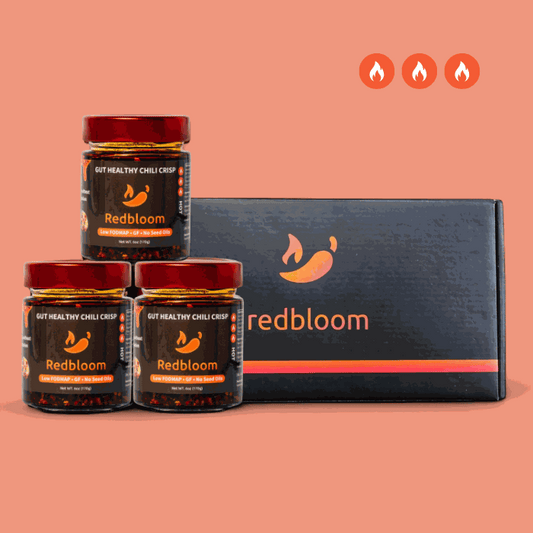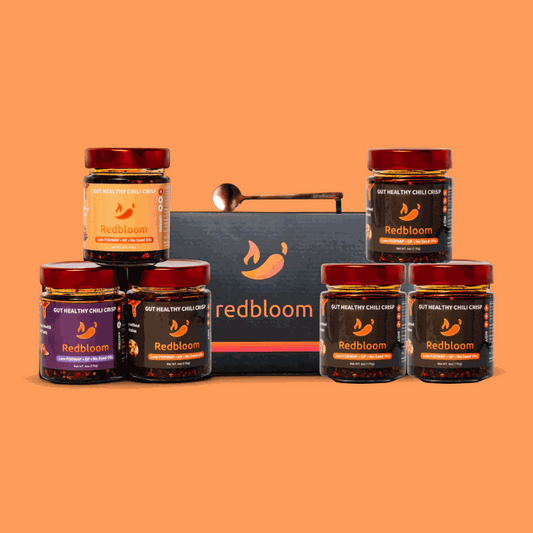Introduction
If you’ve ever felt betrayed by a spicy dish—your mouth loves it, but your stomach wages war—you’re not imagining things. The culprit is likely capsaicin, the active compound in chili peppers that delivers the heat and, for some, a side of gut discomfort. But why does this happen to certain people and not others?
This blog decodes the science of spicy foods, TRPV1 receptors, and gut sensitivity. We’ll clarify the difference between inflammation, hypersensitivity, and food intolerance—and how understanding these systems can actually help you enjoy chili crisp and spicy dishes again, without fear.
Capsaicin: The Molecule That Fires Your Gut’s Alarm
Capsaicin is what makes chili peppers hot. It doesn’t burn tissue, but it tricks your nervous system into thinking you’re on fire. It binds to a receptor called TRPV1 (transient receptor potential vanilloid 1), which is found throughout your digestive tract [1][2][3][4].
When TRPV1 is activated:
-
It causes nerves to fire pain and heat signals
-
It triggers the release of neuropeptides like substance P and CGRP
-
It increases gut motility and fluid secretion, which can cause cramps or urgency in sensitive individuals [2][3][5]
This reaction is normal in moderation. But in people with a sensitive stomach or IBS, the system is on high alert—and capsaicin can send it into overdrive.
TRPV1 and the Sensitive Stomach
Studies show that people with IBS or gut hypersensitivity have higher numbers of TRPV1-expressing nerve fibers in their gut lining [1][3]. That means:
-
Their gut nerves respond to even small amounts of capsaicin
-
This leads to amplified pain, bloating, urgency, or discomfort
-
These symptoms can be confused with inflammation, but often stem from neurological hypersensitivity
Understanding this helps shift the focus from “spicy food is bad” to “my nerves are overreacting.”
Hypersensitivity vs. Inflammation vs. Intolerance
Let’s clarify the terms:
Hypersensitivity
This refers to nerves overreacting to normal stimuli. It doesn’t mean the gut is inflamed or damaged—it just feels like it is. Capsaicin plays a key role here by stimulating TRPV1 and overactivating pain pathways in people who are sensitive [1][2].
Inflammation
True inflammation involves immune activity, swelling, and tissue damage—something seen in IBD, not typical IBS. Most spicy food discomfort isn’t from inflammation, though severe overuse could worsen underlying inflammation [4][5].
Food Intolerance
This is about the gut’s inability to digest certain compounds—like lactose or FODMAPs. Capsaicin isn’t indigestible; it’s just irritating in high doses or to sensitive systems.
Knowing the difference helps you tailor how you manage spicy food—not avoid it altogether.
Can You Train Your Gut to Tolerate Spice?
Yes. TRPV1 receptors can desensitize with slow, controlled exposure to capsaicin. Think of it like strength training for your nerves.
-
Repeated low-level capsaicin exposure leads to reduced TRPV1 sensitivity
-
This reduces the frequency and intensity of pain signals
-
Desensitization is backed by clinical trials showing symptom reduction after 4–6 weeks of regular capsaicin intake [6]
For sensitive stomachs, this means you may be able to enjoy spicy food again—without pain.
Practical Tips for Eating Spicy with a Sensitive Stomach
1. Start Low and Go Slow
Introduce spice gradually. A tiny pinch of chili powder or a few drops of chili oil daily can begin the desensitization process.
2. Use Infused Oils Instead of Raw Chilies
Capsaicin in oil-based form is less aggressive than raw peppers or vinegar-based hot sauces. Try garlic- or chili-infused oils to add flavor without flare-ups.
3. Pair with Gut-Soothing Foods
Balance spice with:
-
Rice or potatoes to absorb capsaicin
-
Yogurt or coconut milk to soothe the lining
-
Low-FODMAP herbs like basil, mint, or turmeric to round out flavor
4. Avoid FODMAP Triggers
Many spicy dishes use garlic and onion, both high in FODMAPs. These can compound discomfort if you’re already sensitive. Use garlic-infused oil or certified Low-FODMAP sauces instead.
5. Track Your Symptoms
Keep a journal or use an app to monitor reactions. This helps identify your personal threshold and adjust your spice intake accordingly.
Quick Reference Table: Capsaicin, TRPV1, and Gut Strategy
| Component | Role in Gut Sensitivity | Strategy |
|---|---|---|
| Capsaicin | Activates TRPV1, triggers pain/burning | Microdose, pair with bland foods |
| TRPV1 receptors | Mediate pain, gut motility, inflammation | Desensitize slowly over time |
| Neuropeptides | Cause inflammation, cramping, urgency | Limit capsaicin during flare-ups |
| FODMAPs | Trigger gas and bloating in IBS | Use infused oils, avoid raw garlic |
| Fat buffers | Slow capsaicin absorption | Use chili in oil form (not vinegar) |
FAQs
1. Why does my stomach hurt from even mild spice?
You likely have increased TRPV1 receptor density, making you more sensitive to capsaicin than average [1][3].
2. Is this a food allergy?
No—this is nerve hypersensitivity, not an immune reaction. Capsaicin isn’t a common allergen.
3. Can I ever enjoy spicy food again?
Yes, with controlled exposure and the right food pairings, many people rebuild tolerance within a few weeks [6].
4. What’s the best type of spice for sensitive guts?
Start with paprika, chili oil, or smoked chili powder. Avoid raw chilies and hot sauces with vinegar.
5. Should I avoid spice entirely if I have IBS?
Not necessarily. If symptoms are manageable, small, regular doses may actually help reduce hypersensitivity over time.
Conclusion
Spicy food isn’t the enemy—it’s your gut’s overreaction to capsaicin that’s the real issue. By understanding how TRPV1 receptors work and how capsaicin stimulates them, you can take control of your relationship with spice.
Whether it’s adjusting your dose, switching to oil-based forms, or pairing with soothing foods, you can find a level of heat that’s satisfying—not sabotaging. Spice smarter, not harder.





